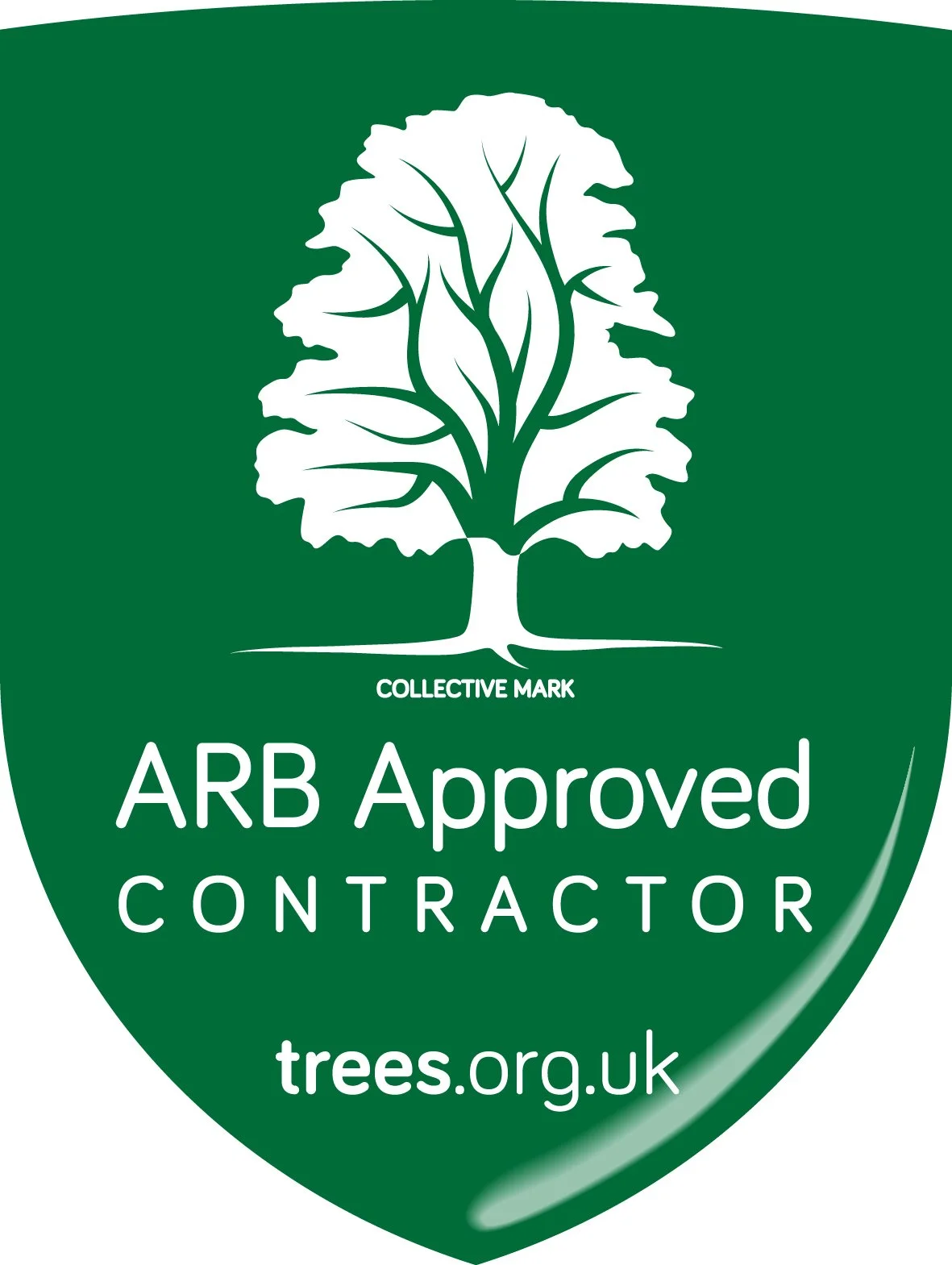Jargon Buster
As with any industry, tree surgery comes with its own mini language! Whilst the below list is not exhaustive it does cover the most common terms you might encounter and will hopefully help to demystify some of the tree surgery process.
-
Angiosperm trees have broad leaves and usually follow a seasonal cycle with their leaves changing colour in autumn and then shedding. Angiosperm trees produce seeds which are enclosed in some way, for example in a fruit like an apple or in an acorn, hence the name: “angio” from the Greek “angeion”, meaning container or vessel, and “sperma”, meaning seed.
-
A system of cables or mesh installed in a tree to help support its structure, a little like a sling on an injured arm. Dartmoor Tree Surgeons exclusively uses Cobra mesh bracing, which allows the tree to move and flex naturally whilst still being supported, meaning that it can build up its own protective wood around its weak areas. Bracing needs to be checked and adjusted approximately every two years and should always be installed professionally.
-
Any tree that has wide, flat leaves as opposed to needles. Examples include oaks, chestnuts, maples and beech trees. These trees usually produce hardwoods and follow a seasonal cycle.
-
The branches and limbs which make up the spreading top of a tree. Can also refer to the tops of a group of trees as a whole, as in “the canopy of the rainforest”.
-
A tree that has needles as opposed to leaves and which produces cones. Conifers are usually evergreen and can be a source of resins and softwoods.
-
This can refer both to an area of woodland in which the trees are regularly cut back to ground level, often to provide firewood and timber, and also to the action of regularly cutting a tree back to stimulate its growth. Beech and hazel coppices are especially common.
-
The crown is the upper part of a tree, made up of its branches and foliage.
-
A decayed tree has had its internal structure partially or wholly destroyed by fungi or bacteria. Decay is not always obvious and can sometimes go unnoticed until it is in an advanced and potentially dangerous stage. Arboricultural consultants and tree surgeons draw on their experience and training to be able to accurately diagnose decay, as well as making use of technologies such as the resistograph.
-
Any tree or plant which sheds its leaves annually, such as oak, beech and sycamore.
-
To take down a tree in gradual stages, often involving rigging or heavy machinery. Dismantling is used when a tree is too big to fell safely in one go or when there are other constraints, such as no clear fell zone.
-
The area underneath and around a tree into which limbs or branches may come during works. The tree surgery team will ensure that nobody enters the drop zone when it might be unsafe to do so.
-
Ecologists are scientists with a special interest in the ecosystem of a site. In relation to tree work, ecologists are often consulted to ensure that the works being done will have the minimum impact on the local plants and wildlife, and are especially concerned with the protection of endangered or threatened species.
-
Evergreen trees and plants keep their leaves all year round and do not change colour in the autumn. Examples include yew, cedar, holm oaks and southern magnolia.
-
To cut down a tree using specific cuts near the base of the trunk, causing the tree to fall.
-
In comparison to angiosperms, gymnosperms have needles as opposed to leaves and keep these all year round rather than shedding them in the winter. The name “gymnosperm” refers to the way that these trees produce seeds which are not enclosed in any protective layer, with the name literally meaning “naked seeds” from the Greek “gymnos” an “sperma”. Pinecones are a classic example of this type of seed.
-
Within tree surgery this refers to the wood of broadleaved trees such as oak, ash and beech. These trees grow more slowly than softwood trees and produce a timber that is (usually) much denser, stronger and heavier, with a notable grain.
-
The wood at the centre of a tree’s trunk and limbs. This wood is often darker and can be aromatic. It is the strongest part of a trees wood.
-
An ancient skill involving the bending and cutting (pleaching) of existing shrubs and small trees to form a natural barrier which will continue to grow and thrive. They are often beautiful and take skill and craftsmanship to complete.
-
One of the large main branch divisions growing from the trunk of the tree.
-
Nesting Bird Season is generally considered to run from the beginning of March to the end of August in the UK. All nesting birds and their nests are protected by law and must not be disturbed. Tree work done during this time must take careful consideration of all nesting sites.
-
When the top and upper branches of a tree are removed to encourage new growth. Creates distinctive “knuckles” on the tree.
-
To cut or trim the branches of a tree or bush to improve appearance and promote growth. Some trees, like apples, strongly benefit from a regular prune, which allows air to circulate more freely within the canopy, encourages fresh growth, and prevents the tree from become overly weighted.
-
A rope system used when climbing and dismantling a tree. Rigging can make use of winches, pulleys and slings and enables the team on the ground and in the tree to safely lower and move large or unwieldy limbs or sections. Training and experience are needed to become a competent rigger and when done properly it not only makes a job much more efficient but can be very satisfying to watch! Our team of tree surgeons are highly experienced with all aspects of rigging and make it look easy...
-
The part of a tree’s root system that keep it anchored in the ground. When a tree is blown over you will often be able to see the root plate pulled up out of the ground.
-
A young tree, especially one which is still slender.
-
The outer “active” layer of a tree’s wood, encircling the heartwood. Water and minerals travel through the sapwood to the branches and leaves of a tree. This part of a tree’s wood is usually paler and softer (relatively speaking!) than the heartwood.
-
Logs which have been slowly allowed to dry, causing them to burn much more easily and for longer, with a hotter flame. It is always recommended to use seasoned logs within the home. Length of effective seasoning can depend on the species of the tree the logs are from, for more information on this please refer to our guide to firewood.
-
In comparison to hardwood, which comes from broadleaf trees, softwood comes from coniferous trees which have needles instead of leaves and which are usually evergreen. These trees tend to grown much more quickly and yield a wood that is lighter and less durable in comparison to hardwoods. There are exceptions to every rule, though, and some softwoods such as the yew are incredibly hard and durable!
-
This is another form of conservation designation, usually given to sites that are especially interesting to scientists because of the rarity of their plant and insect life or for their biodiversity, geology or physiology. Whilst Devon has several fascinating SSSIs, public access is not always allowed in order to afford maximum protection to the sites’ ecology, so Dartmoor Tree Surgeons is particularly lucky to be able to regularly work in these exceptionally beautiful and important areas!
-
The trunk and, sometimes, central limb of a tree.
-
The practice of trimming and training a plant into a certain shape.
-
Trees under a TPO are protected from works unless permission has been given by the local planning authority. It is a crime to carry out management works to these trees without receiving prior consent from your local authority. Dartmoor Tree Surgeons can help with your application and are always happy to provide a wealth of advice on the process! Please also refer to our Quick Guide to Trees and the Law for more information.
-
Usually attached to the local council, a tree officer has responsibility for managing and caring for the trees in their area. This can include checking tree health, accepting or rejecting TPO proposals, organising tree surveys and giving advice to both the public and to professionals.
-
Fresh or “green” wood which still retains its original moisture content. Unseasoned wood is prone to smoking and smouldering and is difficult to burn. The smoke and moisture from unseasoned wood can also cause a build-up of creosote in your chimney.
-
Trees with this designation are particularly old or large. Many have cultural importance and have become part of local lore, such as the Royal or Meavy Oak which can be found in Yelverton. The Ancient Tree Forum provides information on veteran trees throughout the UK, whilst the Ancient Tree Inventory run by the Woodland Trust allows you to add information about veteran trees in your area – give it a go and see what’s near to you!
-
An area which serves a passageway between other natural areas so that wildlife can better disperse and move around, especially within an urban setting. New home developments in particular usually have wildlife corridors factored into their design and these must not be interfered with.



